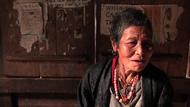Video Overview
An interview with a young lama in Ganden Monastery.
- Ü
- Ganden Gön
- ་
- ཀ་
- ཀསངས་རྒྱས་ཆོས་དང་ཚོགས་ཀྱི་མཆོག་རྣམས་ལ། བྱང་ཆུབ་བར་དུ་བདག་ནི་སྐྱབས་སུ་མཆི། བདག་གིས་ཆོས་ཉན་བགྱིས་པའི་བསོད་ནམས་ཀྱིས། འགྲོ་ལ་ཕན་ཕྱིར་སངས་རྒྱས་འགྲུབ་པར་ཤོག། སངས་རྒྱས་ཆོས་དང་ཚོགས་ཀྱི་མཆོག་རྣམས་ལ། བྱང་ཆུབ་བར་དུ་བདག་ནི་སྐྱབས་སུ་མཆི། བདག་གིས་ཆོས་ཉན་བགྱིས་པའི་བསོད་ནམས་ཀྱིས། འགྲོ་ལ་ཕན་ཕྱིར་སངས་རྒྱས་འགྲུབ་པར་ཤོག སངས་རྒྱས་ཆོས་དང་ཚོགས་ཀྱི་མཆོག་རྣམས་ལ། བྱང་ཆུབ་བར་དུ་བདག་ནི་སྐྱབས་སུ་མཆི། བདག་གིས་ཆོས་ཉན་བགྱིས་པའི་བསོད་ནམས་ཀྱིས། འགྲོ་ལ་ཕན་ཕྱིར་སངས་རྒྱས་འགྲུབ་པར་ཤོགI will go for refuge to the Buddha, Dharma, and Sangha until I achieve enlightenment. May I achieve Buddhahood by the merit of listening to the teachings in order to help sentient beings. I will go for refuge to the Buddha, Dharma, and Sangha until I achieve enlightenment. May I achieve Buddhahood by the merit of listening to the teachings in order to help sentient beings. I will go for refuge to the Buddha, Dharma, and Sangha until I achieve enlightenment. May I achieve Buddhahood by the merit of listening to the teachings in order to help sentient beings.
- ཀགངས་ཅན་མཁས་པའི་རང་གི་གསར་སྐྲུན་ནི། མྱ་ངན་འདས་ཀྱི་འགྲོ་མགོན་སྟོབས་བཅུ་པ། སྟོན་པ་གླང་པོ་དེ་ལ་ཕྱག་འཚལ་ལོ། ཟེར། ད། འདིར་ང་ཚོ་དཔེ་ཆ་ཙེབ་༼སློབ་༽ཡས་འདི་ཡིན་པ་ཡིན་ན། སྟོན་པ་བཅོམ་ལྡན་འདས་ཀྱི་མདོ་གི་ནང་ལ། ཨོའོ། ཨ་ནི་ཐོས་པས་ཆོས་རྣམས་ཤེས་པར་འགྱུར། ཐོས་པས་དོན་མ་ཡིན་པ་བཟློག། ཐོས་པས་མྱ་ངན་འདས་པ་ཐོབ་ཟེར། ཨོའོ་འདུག་ཟེར་གསུང་པ་ནང་བཞིན་གྱིས་དེ་ནི་རྦད་དེ་ཨོའོ་དང་པོ་ཡིན་པ་ཡིན་ན་ཆོས་རྣམས་ཀྱི་གནས་ལུགས། འོ། ཇི་ལྟར་གནས་པ་དེ་རང་རང་སོ་སོས་ཤེས་པ་བྱེད་དགོས་ཀྱི་ཡོད་པ་དེ་གལ་ཆེན་པོ་ཡིན་པ།{note: someone needs to check this quote. no trans.} As for the study of dharma texts, the Buddha said in his Sutra that "Through hearing, one will know phenomena. Through hearing, misconceptions will be eliminated. Through hearing, nirvana will be achieved." Therefore, as quoted, first it is important to know how the reality of phenomena actually eixts.
- ཀཨོའོ། གལ་སྲིད་ཡིན་ན་རྦད་དེ་ཁ་ལ་དོན་དངོས་དང་མཐུན་པའི་གྱི་གནས་ཚུལ་དེ་སོ་སོ་ཀྱིས་ཇི་ལྟ་བ་བཞིན་དུ་མ་ཤེས་པ་ཡིན་པ་ཡིན་ན། ཨོའོ། ཨ་ནི། རྦད་དེ་ཁ་ལ་ཨ་ནི། སོ་སོ་ཀྱིས་བྱས་བཞག་པའི་གྱི་དོན་དག་ཞེ་པོ་ཅིག ཨན། ད་ལམ་ལོག་པ་ལ་འགྲོ་ཡས་འགྲོ་བ་དང་། ནོར་འཁྲུལ་ཡོད་པའི་གི་ལས་ཀ་མང་པོ་ཡོང་ཡས་ཀྱི་ཉེན་ཁ་ཆེན་པོ་ཡོད་བསྡད་པ་དེ་འདྲ་ཅིག་རེད་ཟེར། དེ་ཡིན་པ་ཡིན་སོང་ཙང་། དང་པོ་ཐོག་མ་དེ་ལ་ཡ་ཨཱ་ནི་རྦད་ཆོས་རྣམས་ཀྱི་གནས་ལུགས་ཇི་ལྟ་བ་བཞིན་དུ་ཤེས་པ་བྱེད་དགོས་པ་དེ་གལ་ཆེན་པོ་ཡིན་གསུངས་ཀྱི་ཡོའོ་རེད།So, if we do not know the actual reality correctly at all, many of the acts that we have done will take the wrong paths. There is a danger of engaging in many wrong actions. That is why it is said that first it is important to know the reality of phenomena correctly.
- ཀད་དེ་ཆོས་རྣམས་ཀྱི་གནས་ལུགས་ཇི་ལྟ་བ་བཞིན་དུ་ཤེས་པར་བྱེད་དགོས་ཀྱི་ཡོད་པ་ཡིན་ན། ཨོའོ་ཨ་ནི་ང་ཚོས་ད་ཤེས་ཡས་ཀྱི་ཐབས་དེ་ལ་ཡ། ཨོའོ། ད། སྟོན་པ་སངས་རྒྱས་བཅོམ་ལྡན་འདས་ཀྱིས་ཨ་ནི་མར་གྱུར་ནམ་མཁའི་མཐའ་དང་མཉམ་པའི་སེམས་ཅན་ཐམས་ཅད་ཀྱི་དོན་དུ་དང་པོ་བྱང་ཆུབ་ཀྱི་མཆོག་ཏུ་ཐུགས་བསྐྱེད། ཨ་ནི་བར་དུ་བསྐལ་བ་གྲངས་མེད་པ་གསུམ་དུ་ཚོགས་བསགས། མཐར་མངོན་པར་རྫོགས་པར་སངས་རྒྱས་ནས། འགྲོ་བ་ལ་ཐར་པ་མྱ་ངན་ལས་འདས་པའི་གོ་འཕང་ཐོབ་ཆེད་དུ་གསུངས་བཞག་པ། དེ་ལ་ཡ་ཨ་ནི་ཆོས་ཀྱི་ཕུང་པོ་བརྒྱད་ཁྲི་དང་བཞི་སྟོང་། དེ་རྣམས་ཚུར་བསྡུས་པ་ཡིན་ན་གསུང་རབ་ཡན་ལག་དྲུག་ཅུ། དེ་རྣམས་ཚུར་བསྡུས་པ་ཡིན་ན་གསུང་རབ་ཡན་ལག་བཅུ་གཉིས། དེ་རྣམས་ཚུར་བསྡུས་པ་ཡིན་ན། ཨ་ནི་མདོ་སྡེའི་སྡེ་སྣོད། འདུལ་བའི་སྡེ་སྣོད། མངོན་པའི་སྡེ་སྣོད་ཟེར་བྱས་བྱས།If we want to know the reality of phenomena correctly, as for the methods to know the reality, the Teacher, Bhagavan Buddha first cultivated bodhicitta for all mother sentient beings equal to the limit of the sky; and in the middle he accumulated merit for three countless eons; and in the end after becoming a buddha he taught 84000 teachings for sentient beings to achieve nirvana or liberation. These can be condensed into 60 branches of teachings. These can further be condensed into 12 branches of teachings. These can further be condensed into Sutra collection, Vinaya collection, and Abhidharma collection.
- ཀཨན་ད་ང་རང་ཚོ་རྦད་ནང་པ་སངས་རྒྱས་པ་ཡི་ཆོས་ཀྱི་རྩ་བ་དེ་ལ་ཡ་སྡེ་སྣོད་གསུམ། སྡེ་སྣོད་གསུམ་གྱི་ནང་ལ་བསྡུས། དེ་ནི་གྲངས་ངེས་ཀྱི་ཡོད་ཟེར། དེ་ནི་སྡེ་སྣོད་གསུམ་པོ་འདི་ཉིད་ཀྱི་དོན་དག་དེ་ཉིད། ཨ་ནི་རྦད་ཕྱི་རབས་ཀྱི་གདུལ་བྱ་རྣམས་ཀྱིས་ཇི་ལྟ་བ་བཞིན་དུ་རྟོགས་པ་མ་གྱུར་བ་ཡིན་སོང་ཙང། ཨ་ནི་སྔོན་བྱོན་གྱི་སྐྱེས་བུ་དམ་པ་རྣམས་ཀྱི་དགོངས་པ་འགྲེལ་བ་ལ་མང་པོ་ཅིག་ཡོད་པ་ཡིན་དུས། ཨོའོ། ཨ་ནི་རྦད་འཇམ་མགོན་བླ་མ་ཙོང་ཁ་པ་ཆེན་པོ་ཨོའོ། དེ་ཉིད་ཡིན་ན་རྦད་བསམས་བཞིན་དུ་སྲིད་པ་བཟུང་བྱས། ཨོའོ། ཨ་ནི་རྦད་ཆོས་ཀྱི་ཕུང་པོ་བརྒྱད་ཁྲི་དང་བཞི་སྟོང་གི་སྙིང་པོ་དེ་ཉིད་བསྡུས་པ་ལ་ཡང་། ཨའ། ད་ང་རང་ཚོས་བལྟ་ཡས་དེ་ལ་ཡང་མདོ་ཕྱོགས་ལ་ཡིན་པ་ཡིན་ན། གཞུང་ཆེན་བཀའ་པོད་ལྔ། སྔགས་ཕྱོགས་ལ་ཡིན་པ་ཡིན་ན། ཨོའོ་ཨ་ནི་རྦད་དེ་རྒྱུད་སྡེ་བཞི་ཟེར་གྱི་ཡོའོ་རེད། རྒྱུད་སྡེ་བཞི་དང་ཁྲི་སྡེ་བཞི་ལ་སོགས་པ། ཨོའོ། དེ་འདྲས་ཀྱི་སྒོ་ནས་དེ་ནི་རྦད། ཨོའོ། དང་པོ་དེ་ང་ཚོས་ཐོས་པ་བྱེད་དགོས་པ་ཡིན་ཟེར།The essential teahings of the Buddha are included or in other words enumerated in the three scriptural collections. Since the disciples of the future generation will not realize the meanings of the three scriptural collections correctly, and also since there are many different commentaries by the earlier great holy beings, the Great Jamgon Lama Tsongkhapa intentionally took birth in samsara and instructed us to study the five volumes of extensive texts of the Sutra tradition and the four Tantras and the four instructions of Tantric tradition. This is how we are supposed to study these texts.
- ཀདེ་ཡང་ང་ཚོའི་འཇམ་མགོན་བླ་མ་ཙོང་ཁ་པ་ཆེན་པོས་དེ་ནི་རྦད། དང་པོ་རྒྱ་ཆེན་ཐོས་པ་མང་དུ་བཙལ། བར་དུ་གཞུང་ལུགས་ཐམས་ཅད་གདམས་པར་ཤར། ཐ་མར་ཉིན་མཚན་ཀུན་དུ་ཉམས་སུ་བླངས། གསུངས་པ་ནང་བཞིན། ཨའོ། ཨ་ནི། ང་ཚོས་ད་དཔེ། ཨོའོ། དང་པོ་རྦད་དེ་གང་ལྟར་ཨ་ནི་དཔེ་ཆ་བལྟ་དགོས་ཀྱི་ཡོད་པ་དང་། བར་དུ་ཨ་ནི་རང་གིས་དཔེ་ཆ་བལྟས་བཞག་པ་དེའི་ནང་དོན་གང་ཡིན་པ་དེ། ཨོའོ་ཨ་ནི་སོ་སོ་ཡི་སེམས་ཀྱི་ནང་ལ་འདྲེས་པར་བྱས་བྱས། ཇི་ལྟ་བ་བཞིན་དུ་ཤེས་པར་བྱེད་དགོས་ཀྱི་ཡོད་པ། ཐ་མ་དེ་ལ་ཡ་སོ་སོས་ཤེས་བཞག་པ་དེ་ཤེས་པ་ཡི་ཡུལ་ཙམ་དུ་མ་བཞག་པར་ཨ་ནི་རྦད་སྔོན་བྱོན་གྱི་སྐྱེས་བུ་དམ་པ་རྣམས་ཀྱིས་ཇི་ལྟར་འགྲོ་བ་སེམས་ཅན་རྣམས་ལ་ཕན། ཕན་པ་བདེ་བའི་དོན་དུ་ཉམས་སུ་ལེན་པ་ནང་བཞིན་གྱིས་སོ་སོའི་ལུས་ངག་གིས་ཀྱང་ཨའ། ཨ་ནི་ཉམས་སུ་ལེན་དགོས་ཀྱི་ཡོད་པ།As our Great Jamgon Lama Tsongkhapa said, "First seek for the vast teaching of dharma. In the middle, all the texts will appear as instructions. Finally, practice these day and night." First we have to study, and in the middle we have to understand the meanings by familiarizing our minds with the meaning of the texts that we have studied. And finally just as the great holy beings of the past practiced for the well being of sentient beings, we should physically and verbally practice what has been learned instead of taking them as mere object of knowledge.
- ཀདེ་འདྲ་གཅིག་གསུངས་པ་ཡིན་ཟེར་གྱི་ཡོད་པ་རེད། ད་དེ་ཡིན་དུས་ཙམ་པ། ང་ཚོ་མདོ་ཕྱོགས་ཀྱི་ནང་ལ་ཐོས་བསམ་བྱེད་པ་དེ་ལ་གཞུང་ཆེན་བཀའ་པོད་ལྔ་ལ་ཐོས་པ་བྱེད་པའི་གནས་སྐབས་ལ་ཡང་ཨོའོ། ཞོར་ལ་ཡ་དེ་ནི་རྦད་རྟགས་གསལ་གཏང་ཟེར་བྱས་བྱས་རྩོད་པ་རྩོད་ཡས་ཅིག་ཡོད་པ་ཡིན་པ་རེད། ད་དེ་རྩོད་པ་རྩོད་ཡས་དེ་ཡིན་པ་ཡིན་ན། དགོས་པ་དང་རྒྱུ་མཚན་དེ་ག་རེ་རེད་ཟེར་ལབ་པ་ཡིན་ན། ཨཱ་ནི་ང་ཚོ་འདི་རྩོད་པ་རྩོད་ཡས་དེ། གཅིག། ཨོང་། འགྲོ་བ་རིགས། དེ་ནི་འདི་འགྲོ་བ་རིགས་དྲུག་གི་སེམས་ཅན་ཐམས་ཅད་ཀྱི་ད་བདེ་ཐབས་དང་སྡུག་བསྔལ་སེལ་ཐབས། ཨའོ་དོན་བཟང་པོ་གང་ཡིན་པ་དེ། ཨ་ནི་རྦད་གཞུང་ཆེན་བཀའ་པོད་ལྔ་ལ་སོགས་པ་ཆོས་ཀྱི་ཕུང་པོ་བརྒྱད་ཁྲི་བཞི་སྟོང་གི་ནང་ནས་གསུངས་པ་དེ་ཉིད། རང་གིས་ཇི་ལྟ་བ་བཞིན་དུ་ཤེས་ཡས་ཀྱི་ཆེད་དུ་ཨ་ནི་རྦད་རྩོད་པ་རྒྱག་བསྡད་པ་ཡིན་ཟེར།This is what Lama Tsongkhapa taught. Because of that there is an argumentative process wherein [the monks] do debate during the course of the study of the five volumes of extensive texts of Sutra system. One reason why they do this argumentation is that one has to understand the excellent points explained in the five volumes of extensive texts and the 84000 dharma-teachings correctly in order to bring happiness and eradicate suffering of all sentient beings of the six realms.
- ཀཨ་ནི་ང་ཚོས་རྩོད་པ་རྒྱག་པའི་ནང་དོན་གྱི་སྙིང་པོ་དེ་ཨ་ནི་སོ་སོ་རྦད་དེ་རིག་པ་སྤྱང་པོ་ཆགས་ཡས་འདྲ་པོ་དང་། ཁ་བདེ་པོ་ཆགས་ཡས་འདྲ་པོ་དེ་ཙམ་གྱི་ཆེད་དུ་མ་ཡིན་གསུངས་པ་རེད།So, it is said that the reason why we do this argumentation is not merely for the sake of making oneself intelligent or eloquent.
- ཀཨཱ། མ་ཡིན་པར། ཨ་ནི་རྦད་ང་ཚོ་ལམ་བསླབ་པ་གསུམ། ལུང་སྡེ་སྣོད་གསུམ། ད་ག་ནང་བཞིན་གྱི་ས་བཅུ། ལམ་ལྔ། བདེ་བ་བསྐྲུན་པའི་ཐབས། སྡུག་བསྔལ་སེལ་བའི་ཐབས།Rather, it is for [analyzing points] such as what the reality of things is in reality, what the methods for creating happiness and eradicating suffering are, what the path of the three mental trainings are, what the teachings of the three scriptural teachings are, and what the ten levels and the five paths are. {note: the first line of the next section can be incorporated here. this is how i took it.}
- ཀཨཱ། དོན་དངོས་པོའི་གནས་ཚུལ་ལ་ཡ་གཞི་དངོས་པོའི་གནས་ལུགས་དེ་གང་འདྲ་ཟེར་ཡིན་པ། འོ། དེ་ཚོ་དྲིས་ན་དེ་ནི་དེ་སོ་སོའི་དགེ་བའི་བཤེས་གཉེན་ནམ། ཡང་ན་བླ་མའི་རྩ་ནས་དང་པོ་དཔེ་ཁྲིད་ཀྱི་ནང་ནས་ཉན།First one listens to the teachings that one's teacher or lama gives.
- ཀཨ་ནི། དཔེ་ཁྲིད་ཀྱི་ནང་ལ་ཡ་སྒྲོ་འདོགས་ཇི་ལྟ་བ་བཞིན་དུ་མ་ཆོད་པ་དེ་ཚོ་ཆོས་རྭ་ཡི་ནང་དུ་ཕྱིན་བྱས། ཨ་ནི་རྦད་རྩོད་པ་བྱས། རིག་པས་བརྡར་ཤ་བཅད།Then one engages in argumentation or analysis in debate courtyard on the topics that have not been clarified properly in the class.
- ཀའོ་ཡ། དེ་ནི་རྦད་དེ་གང་ལྟར་ཨ་ནི་ཆོས་རྣམས་ཀྱི་གནས་ལུགས་ཇི་ལྟར་གནས་པ་རྣམས་རང་གིས་ངོས་འཛིན་ཇི་ལྟར་བྱས་པ་ནང་བཞིན་དུ་འཐད་ཀྱི་འདུག་གམ། འཐད་ཀྱི་མི་འདུག་གམ།One analyzes or argues about whether the reality of phenomena agrees with the one that one has identified or not,
- ཀཨཱ། རང་གིས་ངོས་འཛིན་བྱས་པ་དེ་དང་དོན་དངོས་གཉིས་པོ་དེ་མཐུན་གྱི་འདུག་དང་མི་འདུག ཨོའོ། དེ་རྦད་དེ་གང་ལྟར་གྲོགས་ཚངས་པར་མཚུངས་པར་སྤྱོད་པ། ཆོས་རྭ་ཡི་ནང་དུ་ཕར་ཚུར་བགྲོ་གླེང་བྱས་བྱས། གོ་བསྡུར་བྱས་བྱས།whether the reality and the one that has been identified are in agreement or not in the debate courtyard in this mutually beneficial manner.
- ཀཨཱ། རང་གིས་ཤེས་པ་དེ་རོགས་དེ་ལ་ཕར་ངོ་སྤྲོད་བྱེད་ཡས་དང་ མི་གཞན་གྱིས་ཤེས་པ་དེ་རང་གིས་ཚུར་ལེགས་ཆ་ལེན་ཡས། མདོར་བསྡུས་ཏེ་བཤད་ན་རང་དང་གཞན་གཉིས་ཀ་ལ་ཡ་བསམ་པ་གཅིག་མཐུན་ཡོང་གི་འདུག་གམ་མི་འདུགOne discusses and shares with one another by explaining those [points] that one understands to others and by learning the [points] that others know. In brief, one analyzes whether one's point of view and others' point of view agree or not,
- ཀརང་དང་གཞན་གྱིས་ཇི་ལྟར་ངོས་འཛིན་བྱས་པ་དེ་བཀའ་མདོ་རྒྱུད་དྲི་མ་མེད་པ་རྣམས་དང་མཐུན་གྱི་འདུག་གམ་མི་འདུག དེ་བརྟག་དཔྱད་བྱས་བྱས་ཨ་ནི་དེ་དག་གི་ནང་ནས་རྦད་ལེགས་པའི་ཆ་གང་ཡིན་པ་དང་། དེ་ཇི་ལྟ་བ་བཞིན་དུ་ཤེས་ཡས་ཀྱི་ཆེད་དུ། འོ་ཨ་ནི་ང་ཚོ་རྦད་དཔེ་ཆ་རྩོད་པ་རྒྱག་དགོས་ཡས། སྒྲོ་འདོགས་གཅོད་དགོས་ཡས་ཀྱི་གནས་ལུགས་རྒྱུ་མཚན་དང་མ་སོང་ན་ང་ཚོ་འདི་འདྲས་གཅིག་ཡིན་ཟེར།whether those that one and others have identified concur with the infallible Sutras and Tantras of the Buddha's teachings. Such analysis is done for the purpose of understanding the good points that are in those texts. This is the reason why we do argumentation and why we engage in the process of clarification of doubts.
- ཀཨཱ། དེ་ནི་དཔེ་ཆ་བལྟ་བཞག་པ་དེ་ལ་ཕན་འདོགས་འདྲ་པོ་གཅིག་ག་རེ་ཡོང་གི་རེད་ཟེར་ལབ་པ་ཡིན་ན། དང་པོ་དམིགས་ཡུལ་ལ་ཡང་ད་ཆོས་རྣམས་ཀྱི་གནས་ལུགས་བདེན་པའི་དོན་གང་ཡིན་པ་དེ་ཉིད་ཇི་ལྟ་བ་བཞིན་དུ་ཤེས་ཡས་ཀྱི་ཆེད་དུ་རྩོད་པ་ནང་བཞིན།What are some of the benefits that one gets from studying dharma texts? Just as initially one's objective to do argumentation is to understand all the possible realities of all phenomena,
- ཀམཇུག་མར་རྩོད་པ་དང་མཐར་ཕྱིན། དཔེ་ཆ་ཡག་པོ་ཞིག་ཆགས་ཡོང་དུས་ཙམ་པ། ད་ལམ་ལོག་པ་ལ་མ་འགྲོ་བདེ་བ་། བདེན་པའི་དངོས་པོ་ཡང་དག་པ་ཇི་ལྟ་བ་བཞིན་དུ་གནས་པ་དང་སོ་སོ་ཡིས་རྦད་རང་གིས་ཡིན་པ་ཡིན་ན་ངོས་འཛིན་བྱེད་ཐུབ་པ།a benefit that one reaps from studying these texts is that when one becomes a master of argumentation later and become knowledgeable in dharma texts, one will not easily fall into the trap of wrong path, one will even be able to identify the reality correctly,
- ཀམི་གཞན་ལ་ཕར་ངོ་སྤྲོད་བྱེད་དགོས་བྱུང་ན་ཡང་ཇི་ལྟ་བ་བཞིན་དུ་ངོ་སྤྲོད་བྱེད་ཐུབ་མཁན། འོ་དེ་འདྲས་གཅིག་ཆགས་ཀྱི་ཡོའོ་རེད་ཟེར།and one will also be able to explain the meaning to other people, should the need arise. This is what one becomes from studying these texts.
- ཀཨ་ནི་ཞར་བྱུང་གི་ཚོད་དུ་བཤད་པ་ཡིན་ན་གཅིག་གི་ཆོས་དང་འཇིག་རྟེན། ད་ག་ནང་བཞིན་གྱི་གཅིག་རིག་པ་ཡིས་བསམ་བློ་བཏང་སྟངས། གང་ཅིའི་ཐད་ལ་ཡང་དེ་ནི་ང་ཚོ་དེར་སྤྱང་གྲུང་དང་ལྡན་པ་དེ་འདྲ་ཅིག་ཆགས་ཀྱི་ཡོའོ་རེད། དེ་ང་ཚོས་ཨ་ནི་རྩོད་པ་བརྒྱབ་པ་དེ་ང་ཚོའི་དགོས་པ་གཙོ་བོ་ཟེར་གའི་མ་རེད། ཁོ་ཞར་བྱུང་གི་ཚུལ་དུ་ཁོ་རང་གི་ཞོར་ཀྱག་ལ་བྱུང་བ་ཅིག་ཡིན་ཟེར་བྱས།As for the byproducts of studying these texts, it is good for both dharma and secular actions; it makes us think naturally with intelligence; and it makes us do well in anything. These are not the main purposes of doing argumentation. They come as byproducts.
- ཀའོ། དེ་ནི་ང་ཚོས་མདོ་ཕྱོགས་ལ་རྩོད་པ་བརྒྱབ་པའི་སྐབས་སུ། གཞུང་ཆེན་བཀའ་པོད་ལྔ་ཟེར་ཡས་དེ་ཡང་ཆ་མཚོན་པ་ཡིན་ན། ཨ་ནི་ང་ཚོའི་འདིར་གཞུང་ཆེན་བཀའ་པོད་ལྔ་དེ་ལ་ཡ། ཚད་མ་རིག་པ། ཕར་ཕྱིན། དབུ་མ། མཛོད། འདུལ་བ་ཟེར་བྱས་བྱས། ང་ཚོས་དེ་མིང་ལ་ཡ་གཞུང་ཆེན་བཀའ་པོད་ལྔ་ཟེར་གྱི་ཡོད་པ་རེད།As for the five volumes of extensive texts that are debated upon during the period of studying Sutra texts, they are the texts that deal with valid cognitoin, perfection of wisdom, middle-way, abhidharma, and monastic disciplines. These are called the Five Volumes of Extensive Texts.
- ཀཨཱ། ཨ་ནི་གཞུང་ཆེན་བཀའ་པོད་ལྔ་ཡི་ནང་ནས་དང་པོ་ང་ཚོ་ཚད་མ་རིག་པ་ཟེར་མཁན་དེ། ད་སློབ་དཔོན་ཆོས་ཀྱི་གྲགས་པས་བརྩམས་བཞག་པའི་ཚད་མ་རྣམ་འགྲེལ་གྱི་ཚིག་ལེའུར་བྱས་པ་ལེའུ་བཞི་ཡི་བདག་ཉིད་ཅན་ཞིག་ཡོའོ་རེད་པཱ།As for the study of valid cognition of the Five Volumes of Extensive Texts, it is the Pramanavartikakarika consisting of four chapters written by Acarya Dharmakirti.
- ཀདེ་ཨ་ནི་དེང་སང་ལ་ཡིན་པ་ཡིན་ན། ཚད་པ་རིག་པ་ལྟ་མཁན་གྱིས་གཞི་འཛིན་ས་གཙོ་བོ་ང་ཚོ་འདི་བྱེད་ཀྱི་ཡོའོ་རེད། དེ་ཡི་ནང་དོན་གཏན་ལ་ཕབ་པ་དེ། འདི་ལྟ་བུ་ཡི་ཚད་མ་རྣམ་འགྲེལ་དེ་ཡང་སློབ་དཔོན་ཆོས་ཀྱི་གྲགས་པས་ཀྱིས་རང་དགར།This is the primary source for those who study valid cognition these days. Acarya Dharmakirti did not write this text for no particular reason,
- ཀཨཱ། བརྩམས་བཞག་པ་ཞིག་མ་ཡིན་པར་ཡང་དག་པའི་རྫོགས་པའི་སངས་རྒྱས་ཀྱི་ཨ་ནི་རྦད་ཆོས་ཀྱི་ཕུང་པོ་བརྒྱད་ཁྲི་བཞི་སྟོང་གི་སྙིང་པོ་ཡི་ནང་ནས་ད་ལྟ་ང་ཚོའི་རྦད་ཨ་ནི་འཁོར་ལོ་གསུམ་གྱི་ནང་ནས་འཁོར་ལོ་དེ་ནི་ཐ་མ་ལེགས་པར་རྣམ་པར་ཕྱེ་བའི་ཆོས་འཁོར་ཟེར་མཁན་གཅིག་ཡོའོ་རེད། འོ་འདི་ཡི་དགོངས་པ་དེ་ཉིད་གཙོ་བོར་འགྲེལ་བྱས།rather he [wrote it] in order to unravel the thoughts of the Final Wheel of the Doctrine of Good Distinction of the Three Wheels, which is the essence of the 84000 dharma-teachings of the Buddha.
- ཀཨ་ནི་སྤྱིར་ཆོས་ཀྱི་ཕུང་པོ་བརྒྱད་ཁྲི་བཞི་སྟོང་ཐམས་ཅད་ཀྱི་དགོངས་པ་འགྲེལ་བ་ཡིན་ཟེར། དེའི་ནང་དོན་ལ་ཆ་མཚོན་པ་ཡིན་ན། དེ་ནི་ང་རང་ཚོའི་རིག་པའི་འགྲོ་སྟངས་ཀྱི་རྣམ་གཞག། དོན་དངོས་དང་མཐུན་མ་མཐུན་གྱི་ཚད་གཞི་ཟིན་ས།Generally speaking, it is said that the text unravels the thoughts of all 84000 dharma-teachings. As for the content of the text, it is about the system of logic and about invalid cognition and valid cognition that decipher whether something is factually true or not.
- ཀཚད་མ། ཨ་ནི་ཚད་མ་མ་ཡིན་པ། ད་ག་ནང་བཞིན་གྱི་མངོན་སུམ་དང་རྗེས་དཔག་ལ་སོགས་པ། དེ་ནི་སྐྱེ་བ་སྔ་ཕྱི། ལས་རྒྱུ་འབྲས། དེ་ནི་འཐོབ་བྱ་ག་རེ་ཡིན་པ འཐོབ་བྱ་མ་ཡིན་པ་ག་རེ་ཡིན་པ། སྤང་བྱ་དང་བླང་བྱ་ལ་སོགས་པའི་གཞི་འཛིན་ས་ཡི་ཚད་གཞི་འཛིན་ས། དེ་གཙོ་བོ་ང་ཚོ་ཚད་མ་རྣམ་འགྲེལ་གྱི་ནང་ནས་གཏན་ལ་ཕབ་པ་ཡིན་པ།{note: the first half of the first line can go with the previous section.} Similarly, the text is the foundation for the presentation of direct perceptions and inferences, past and future births, karmic causes and effects, what is to be achieved and what is not to be achieved, and what is to be adopted and what is to be eradicated. So, Pramanavartika text primarily presents these topics.
- ཀཨཱ། གཉིས་པ་དེ་ལ་ང་ཚོའི་འདི་ལ་ཕ་རོལ་ཕྱིན་པ་ཟེར་མཁན་འདི་ཡིན་པ་ཡིན་ན། ད་ད་ལྟ་གཞི་འཛིན་ས་དེ་ཡིན་པ་ཡིན་ན། ང་ཚོའི་འདིར་རྒྱལ་བ་བྱམས་པ་མགོན་པོས་བརྩམས་བཞག་པ་ཡིན་པ།As for the second one, the perfection of wisdom, Maitreya's Abhisamayalamkara is used as the primary source.
- ཀབསྟན་བཅོས་མངོན་རྟོགས་རྒྱན། འོ་དེ་ཉིད་ལ་གཞི་འཛིན་བྱས། ཨ་ནི་མི་གང་ག་ལོགས་ཀྱིས་རྦད་ང་ཚོ་ཕལ་ཆེར་འདིའི་སྒོ་ནས་སྒྲོ་འདོགས་གཅོད་ཀྱི་ཡོད་པ་རེད།{note: the first two parts of the first line can go in the previous section.} The Perfection of Wisdom Vehicle clarifies the doubts of all people.
- ཀཨ་ནི་ཕ་རོལ་ཏུ་ཕྱིན་པའི་དེ་ནི་བསྟན་བཅོས་མངོན་རྟོགས་རྒྱན། འདིའི་བཤད་བྱ་རྩ་བའི་མདོ་ལ་ཆ་བཞག་པ་ཡིན་ན། ཨ་ནི་རྦད་བཅོམ་ལྡན་འདས་ཀྱིས། ཨཱ། ཆོས་ཕུང་བརྒྱད་ཁྲི་བཞི་སྟོང་གི་ནང་དོན་གྱི་སྙིང་པོ་བསྡུས་བཞག་པ་དེ་ལ་ཡ། དེ་ནི་ང་ཚོས་འདིར་ཤེར་ཕྱིན་གྱི་མདོ་སྡེ་རིན་པོ་ཆེ་ཟེར།The Precious Perfection of Wisdom Sutras, which condenses the essential meaning of the 84000 dharma-teachings of Bhagavan, are the main concerns of Abhisamayalamkara.
- ཀདེང་སང་ཡོངས་སུ་གྲགས་པ་ལ་ཡ་ད་ཡུམ་རྒྱས་འབྲིང་བསྡུས་གསུམ་ཟེར་གྱི་ཡོའོ་རེད། འབུམ་ལ་པོད་བཅུ་གཉིས་དང་། ཨཱ་ཉི་ཁྲི་ལ་པོད་གསུམ། བརྒྱད་སྟོང་པ་ལ་ཡིན་ན།They are widely known as the Extensive, Middling, and the Condensed Wisdom Sutras.
- ཀཨོའོ། པོད་གཅིག་ཡོད་བསྡད་པ། འོ་དེ་ཡི་ནང་དོན་དེ་ཉིད་ཨ་ནི་གཏན་ལ་འབེབ་པ་ལ་བསྟན་བཅོས་མངོན་རྟོགས་རྒྱན། དེ་ཨ་ནི་རྦད་གདན་ས་གསུམ་གྱི་མཁས་པ་དང་དགེ་བའི་བཤེས་གཉེན་རྣམས་ཀྱིས་ཕར་ཕྱིན་ལ་ཡ་ལོ་མང་པོ་རྩོད་པ་བརྒྱབ་བྱས་དེའི་ནང་དོན་སྦྱང་གི་ཡོའོ་རེད།{note: the first part should be a part of the previous sentence.} Abhisamayalamkara [was written] in order to present the meaning of these sutras. And scholars and teachers at the three seats of Gelug monasteries study the meanings of this text by debating on perfection of wisdom for many years.
- ཀདེའི་ནང་དོན་ལ་ཆ་མཚོན་པ་ཡིན་ན། གཙོ་བོ་གཅིག་ང་ཚོ་དེ་ནི་རྦད་བྱམས་པ་དང་སྙིང་རྗེ། བྱང་ཆུབ་ཀྱི་སེམས། འགྲོ་བ་རིགས་དྲུག་གི་སེམས་ཅན་དེ་དག་ཐམས་ཅད་ལ་རྦད་དེ་གང་ལྟར་ཨ་ནི་ཨ་དོན་དུ་ཨ་ནི་རང་རྦད་ཡལ་བར་དོར།As for the content of this text, the text primarily elaborates on love, compassion, bodhicitta, forsaking oneself for the sake of all sentient beings of the six realms,
- ཀའོ། རིགས་དྲུག་གི་སེམས་ཅན་འདི་དག་གི་དོན་དུ། རྦད་རང་གི་ལུས་ལུས་སྲོག་ཨོའོ། དུས་གསུམ་དགེ་རྩ་དང་བཅས་པ་ཐམས་ཅད་བཏང་བྱས། འགྲོ་བ་རིགས་དྲུག་གི་སེམས་ཅན་ལ་ཡ་ཕན་བདེ་བསྒྲུབ་དགོས་ཀྱི་ཡོད་པའི་རྣམ་གཞག་འོ་དེ་འདྲ་གཅིག་གསུངས་ཡོད་པ་ཅིག་ཡིན་པ་རེད།sacrificing one's body and life, and giving all root virtues of the three times for the sake of sentient beings of the six realms, and how to help sentient beings of the six realms. {note: this section can go with the previous section.}
- ཀདེ་ལྟ་བུའི་དེ་ནི་རྦད་ཕན་བདེ་ཡི་རྣམ་གཞག་དེ་ཉིད། ཨ་ནི་རང་གིས་གང་འདྲ་ཟེ་ཉམས་སུ་ལེན་དགོས་ཀྱི་ཡོད་པ། དེ་ལྟ་བུའི་ཕན་བདེ་དེ་ཉིད་སྒྲུབ་པ་ལ་ཡ། རང་ལ་ཡིན་པ་ཡིན་ན་དཀའ་ངལ་མི་ཉུང་བ་ཞིག་འཕྲད་སྲིད་པ་ཡིན་པ་ཡིན་སོང་ཙང་། དཀའ་ངལ་དེ་ཚོ་ལ་ཡ་དཀའ་ངལ་སེལ་ཐབས་གང་འདྲས་ཟེ་ཡོད་པ།The text presents how one can put these concepts in practice. Since one could encounter some problems when helping others, [the text explains] different methods for getting rid of those problems.
- ཀརང་གཅེས་པར་འཛིན་པའི་གཅེས་འཛིན་དེ་ང་ཚོས་མགོ་འཇོམས་སྟངས་དེ་གང་འདྲས་ཟེར་ཡིན་པ། མར་གྱུར་ནམ་མཁའི་མཐའ་དང་མཉམ་པའི་སེམས་ཅན་རིས་སུ་མ་ཆད་པ་ལ་ཡ། ཉེ་རིང་ཆགས་སྡང་དང་འདོད་ཆགས་ཞེ་སྡང་ལ་སོགས་པའི་དབང་དུ་མ་སོང་བར།[The text also explains] how egoistic attitude can be eliminated and how we should help undifferentiated mother sentient beings that are equal to the limit of the sky as much as possible without going under the influence of attachment to the close ones, hatred to the distant ones, and so forth. {note: a part of next section can go in this section.}
- ཀགང་ག་ལ་རིས་སུ་མ་ཆད་པ། རང་གིས་ད་གང་ཕན་ཅི་ཕན་བྱེད་དགོས་ཀྱི་ཡོད་པ། གནས་ལུགས་རྒྱུ་མཚན་གང་འདྲས་ཟེ་ཡིན་པ། འོ་དེ་དང་འབྲེལ་བའི་སྒོ་ནས་དེ་ནི་དངོས་པོ་བརྒྱད་དང་དོན་བདུན་ཅུའི་སྒོ་ནས་གཏན་ལ་འབེབས་པ་ཡིན་ཟེར།[The text] establishes how such thing is the case by getting into the topics of Eight Realities and Seventy Points.
- ཀཨ་ད་དེ་གས་དེ་ལ་སྦྱངས་སོང་ན། ང་ཚོ་དབུ་མ་དབུ་མ་ཟེར་མཁན་འདི་ཡིན་པ་ཡིན་ན། དབུ་མ་ཡི་དེ་ནི་ང་ཚོ་གཞི་འཛིན་ས་ཁོ་གཙོ་བོ་དེ་དམ་པ་དེ་ཡིན་པ་ཡིན་ན། དབུ་མ་རྩ་བ་ཤེས་རབ་དང་། དབུ་མ་འཇུག་པ་ཟེར་གྱི་ཡོད་པ་རེད།When this is done, [one studies] the middle-way. The primary sources for the middle-way topic are Madhyamikakarika and Madhyamikavatara.
- ཀདབུ་མ་དེ་ནི་རྩ་བ་ཤེས་རབ་དེ་དཔལ་མགོན་འཕགས་པ་ཀླུ་སྒྲུབ་ཀྱིས་བརྩམས་བཞག་པ། འོ་དབུ་མ་དེ་ནི་འཇུག་པ་དེ་དཔལ་ལྡན་ཟླ་བ་གྲགས་པས་བརྩམས་བཞག་པ་ཡིན་པ།Madhyamikakarika was written by Glorious Arya Nagarjuna. And Madhyamikavatara was written by Glorious Candrakirti.
- ཀཨཱ། དེ་གཉིས་ཀྱི་བཤད་བྱ་རྩ་བའི་མདོ་ལ་ཆ་མཚོན་པ་ཡིན་ན། ཡང་གོང་དུ་བཤད་པ་ནང་བཞིན་གྱི་དེ་ནི་རྦད་ཡུམ་རྒྱས་འབྲིང་བསྡུས་གསུམ། འདི་གའི་སྒང་ལ་ཡ་དེ་ནི་བློ་གྲོས་མི་ཟད་པས་བསྟན་པའི་མདོ་ལ་སོགས་པ་ལ་དེ་ནི་ཁུངས་གཏུགས་བྱས་ཆོས་རྣམས་ཀྱི་གནས་ལུགས་གཙོ་བོ་གཏན་ལ་ཕབ་པ་ཡིན་ཟེར།As for the primary sutras that are explained here, it is the Extensive, Middling, and the Condensed Wisdom Sutras as mentioned above, and Aksayamatinirdesasutra, and so forth in addition. They [the two texts] primarily present the reality of all phenomena by employing these sutras as sources.
- ཀདེ་ཡང་ང་ཚོ་ནང་དོན་ལ་ཆ་མཚོན་པ་ཡིན་ན། ས་བཅུ་ལམ་ལྔ། དེའི་སྒང་ལ་ཡ་སོ་སོ་སྐྱེ་བོ་ཡི་ས་དེ་ནི། གསུམ་གྱིས་ཚུར་ཁ་བསྐངས་བྱས་བཤད་ནི། དེ་ཡི་ནང་དོན་གཙོ་བོ་ལ་ཆ་མཚོན་པ་ཡིན་ན།As for the content of the texts, it is about ten levels and five paths, and 3 levels of ordinary beings can be supplemented also.
- ཀཨཱ། ཨ་ནི་རྦད་དེ་འགྲོ་བ་རིགས་དྲུག་གི་སེམས་ཅན་དེ་དག་ཐམས་ཅད། རང་བཞིན་སེམས་ཅན་རྣམས་ལ་ཡ་སྡུག་བསྔལ་ཡོང་ཡས་ཀྱི་རྩ་བ་དེ་ག་པར་ཐུག་གི་འདུག་གམ།{note: the last part of the previous section can go in this section.} The primary meanings of these texts deal with [topics such as] the identification of the root cause of suffering by analyzing where the root cause of suffering of sentient beings of the six realms lies,
- ཀབདེ་བ་འབྱུང་དགོས་ཀྱི་ཡོད་ན། ང་ཚོ་གང་འདྲས་ཟེ་བྱས་བྱས་བདེ་བ་ཡོང་ཐབས་བྱེད་དགོས་ཀྱི་འདུག་ག། རྩད་བཅད་བྱས་ཨ་ནི་རྦད་སྡུག་བསྔལ་ཡོང་བའི་རྩ་བ་དེ་ངོས་གཟུང་བ།how one can achieve happiness if we want happiness,
- ཀསྡུག་བསྔལ་ཡོང་བའི་རྩ་བ་དེ་ང་ཚོས་དེ་ནི་མེད་པ་བཟོ་ཐབས་ཀྱི་གཉེན་པོ། ཆོས་རྣམས་ཀྱི་གནས་ལུགས་རྟོགས་པའི་ཤེས་རབ། སྟོང་ཉིད་རྟོགས་པའི་ཡེ་ཤེས་དེ་ཉིད། ཨ་ནི་ང་རང་ཚོས་རང་རྒྱུད་ལ་སྐྱེ་སྟངས་བྱེད་ཡས་གང་འདྲས་ཟེར་སྐྱེད་པར་བྱེད་དགོས་ཀྱི་ཡོད་པ།and how we can develop the wisdom realizing emptiness, the wisdom realizing the reality of phenomena, the antidote which eradicates the root cause of suffering.
- ཀའོ། མདོར་བསྡུས་ཏེ་བཤད་ན། དེ་ནི་ང་ཚོ་འདི་གཙོ་་བོ་ཆོས་རྣམས་ཀྱི་རང་བཞིན་གནས་ལུགས་མཐར་ཐུག་པ་ངོ་མ་ངོ་ཐག་གི་ཆོས་དེ་གང་འདྲས་ཟེར་སྒྲུབ་ཀྱི་ཡོད་པ། འོ་དེ་གཙོ་བོ་གཏན་ལ་ཕབ་པ་ཡིན་པ་རེད།In brief, the texts extablish how the real object, the ultimate mode of existence of phenomena, can be proven.
- ཀའོ་དེ་ནས་ང་ཚོ་དེ་མཛོད་ཟེར་མཁན་འདི་ལ་ཆ་བཞག་པ་ཡིན་ན། ཨོའོ་ད་ལྟ་ང་ཚོ་དེ་ནི་རྦད་ཡོངས་གྲགས་ཀྱི་གདན་ས་གསུམ་གྱི་སློབ་སྦྱོང་བྱས་བྱས། གཞི་འཛིན་ས་དེ་ལ་ཡང་མཛོད་རྩ་བ་ཟེར་གྱི་ཡོད་པ་རེད།And then as for the study of abhidharma, the main source book that the three seats of Gelug monasteries study is called Abhidharmakosa.
- ཀའོ་སློབ་དཔོན་དེ་ནི་རྦད་དེ་རྒྱལ་མཆོག་དབྱིག་གཉེན་གྱིས་བརྩམས་བཞག་པ་ཡིན་པ། འདི་ཡི་བཤད་བྱ་རྩ་བའི་མདོ་ལ་ཆ་མཚོན་པ་ཡིན་ན།And it was written by Acarya Vasubandhu. The primary sutras that this text explains are
- ཀའོ་ཨ་ནི་རྦད་དེ་བཀའ་འགྱུར་ནང་ལོགས་ནས། ཨོའོ་མདོའི་ནང་ལ་ཡོད་བསྡད་པ་དེ། ཨ་ནི་མངོན་པ་སྡེ་བདུན་ཟེར་བྱས་བྱས་པོད་བདུན་ཐམ་པ་ཡོད་གནང་གི་ཡོད་པ།{note: we can move the last part of the previous section here} the 7 sets of abhidharma texts from Kagyur (the Tibetan Translation of Sutras).
- ཀདེ་ལྟ་བུའི་དེ་ནི་པོད་བདུན་དེ་བྱས་ནས། ཨ་ནི་དེའི་དགོངས་པ་འགྲེལ་བ་ལ་དེ་ནི་རྦད་སློབ་དཔོན་ཟེར་ཨོའོ་ང་ཚོ་འདི་དེ་ནི་རྒྱལ་མཆོག་དབྱིག་གཉེན་གྱིས་མཛོད་རྩ་བ་ཟེར་མཁན་དེ་བརྩམས་པ་ཡིན་པ་རེད། མཛོད་རྩ་བའི་ནང་དོན་ལ་ཆ་མཚོན་པ་ཡིན་ན།And in order to unravel the meaning of these texts, Acarya Vasubandhu wrote the text called Abhidharmakosa. As for the meaning of Abhidharmakosa,
- ཀཨོའོ་ད་རྦད་དེ་ཧ་ཅང་གི་ཁྱབ་ཆེན་པོ། འཇིག་རྟེན་ཐོག་ལ་ཡོད་ཚད་ཐམས་ཅད་གཏན་ལ་ཕབ་ཀྱི་ཡོའོ་རེད། དེ་ཡི་ནང་ལ་དེ་ནི་རྦད་ཡར་རྫོགས་པའི་སངས་རྒྱས་ཀྱི་གོ་འཕང་འཐོབ་ཡས་དང་། མར་འཁོར་བའི་ནང་ལ་འཁོར་ཡས་ཀྱི་ལོ་རྒྱུས་བཤད་ཀྱི་ཡོད་པ།{note: the last part of the previous section can go here} it is very broad as it presents everything that exists in universe. It explains how one can achieve the complete Buddhahood and the causes that make a person take rebirths in samsara.
- ཀདེ་ག་ནང་བཞིན་གྱི་དེ་ནི་ཉི་ཟླ་ཡི་ཆགས་ཚུལ་བཤད་ཀྱི་ཡོའོ་རེད། རི་རབ་བཤད་ཀྱི་ཡོའོ་རེད། གླིང་བཞི་བཤད་ཀྱི་ཡོའོ་རེད། གླིང་ཕྲན་བཤད་ཀྱི་ཡོའོ་རེད།Similarly, it explicates how the sun and the moon were formed; it talks about Mt. Meru, four continents, and subcontinents.
- ཀའཛམ་བུ་གླིང་གི་འགྲོ་སྟངས་ལ་སོགས་པ་ཡང་གསུངས་ཀྱི་ཡོའོ་རེད་ལ། ང་རང་ཚོའི་མིའི་སྐོར་གྱི་རྣ་བ་སྣ་ལྕེ་ལ་སོགས་པའི་ལུས་ཀྱི་གྲུབ་ཆ་ནས་བྱས་པ་ཅིག་གིས་མདོར་བསྡུས་ཏེ་བཤད་ན་སེམས་ཅན་མངལ་དུ་ཉིང་མཚམས་སྦྱོར་བ་དང་།It also explains the structures of the world, etc. And in brief, it is said that Abhidharmakosa presents everything including our eyes, ears, nose, and tongue that compose our physical bodies right from the moment we get conceived in womb; and it correctly presents earth, stones, Mt. Meru, and so forth of this universe and the universe beyond.
- ཀའ། ཨ་ནི་འཇིག་རྟེན་གྱི་་ཁམས་འདི་དང་འཇིག་རྟེན་གྱི་ཁམས་གཞན་ལ་སོགས་པ། ད་ས་རྡོ་རི་རབ་དང་བཅས་པ་ཡོངས་སུ་རྫོགས་པའི་རྣམ་གཞག་ཇི་ལྟ་བ་བཞིན་དུ། ཆོས་མངོན་པ་མཛོད་ཀྱི་ནང་དུ་གཏན་ལ་འབེབ་པ་ཡིན་ཟེར།{note: we can move this whole section into the previous one. Translation is in the previous section.}
- ཀཨཱ་དེ་ལ་ཡང་དེ་ནི་ང་ཚོའི་འདིའི་དོན་དག་ལ་ཡིན་པ་ཡིན་ན། ང་ཚོ་ཁམས་བསྟན་པ་དང་། དབང་པོ་བསྟན་པ། ད་ག་ནང་བཞིན་གྱི་དེ་ནི་འཇིག་རྟེན་བསྟན་པ། ལས་བསྟན་པ། ཕྲ་རྒྱས་བསྟན་པ། དེ་ནས་ལམ་དང་གང་ཟག་བསྟན་པ། ཡེ་ཤེས་བསྟན་པ།As for the content of this text, there are eight: Presentation of Constituents, Presentation of Orgrans, Presentation of the Universe, Presentation of Karma, Presentation of Afflictive Emotions, Presentation of Path and Person, Presentation of Wisdom, and Presentation of Meditative Absorption.
- ཀསྙོམས་པར་འཇུག་པ་བསྟན་པ་ཟེར་བྱས་ང་ཚོ་དོན་དག་བྱས་ན་བརྒྱད་ཡིན་པ་རེད། ཡིན་ཀྱང་དོན་དག་བརྒྱད་པོ་ཧ་ཅང་གིས་ཁྱབ་ཆེ་བསྡད་པ་ཡིན་པ།{note: the first part of this section can go in the previous section} The meanings of these eight are very broad though.
- ཀད་འཇིག་རྟེན་གྱི་ཐོག་གི་དེང་སང་ཡིན་པ་ཡིན་ན། ས་ཁམས་རིག་པ་ཟེར་མཁན་འདྲ་པོ། དངོས་ཁམས་རིག་པ་ཟེར་མཁན་འདྲ་པོ་དེ་ཚོ་གང་ག་ལོགས་རྦད་དེ་མཛོད་ཀྱི་ནང་དོན་མཛོད་ཀྱི་ཆ་རྐྱེན་བྱེ་བྲག་དེ་འདྲས་གཅིག་ཆགས་བསྡད་ཡོའོ་རེད། འོ་འདི་འདྲས་གཅིག་ཡིན་ཟེར།Geography, physics, and so forth that deal with the studies of universe these days are a small part of the abhidharma study.
- ཀད་དེ་ནས་དམ་ཆོས་འདུལ་བ་ཟེར་མཁན་འདི་ལ་ཆ་མཚོན་པ་ཡིན་ན། ད་འདི་ང་ཚོ་དེ་ནི་ལྟ་ཡས་ཀྱི་དཔེ་ཆ་ཡི་གཞི་འཛིན་ས་དེ་ལ་ཡ། འདུལ་བ་མདོ་རྩ་བ་ཟེར་བྱས་བྱས། བམ་པོ་དགུ་ཡི་བདག་ཉིད་ཅན། སློབ་དཔོན་ཡོན་ཏན་འོད་ཀྱིས་བརྩམས་གནང་པ་རེད།The primary source for the study of Vinaya, the holy dharma, is Acarya Gunaprabha's Root Text of the Vinaya Sutra which contains nine volumes.
- ཀའདི་ཡིས་བཤད་བྱ་རྩ་བའི་མདོ་ལ་ཆ་བཞག་ན་བཀའ་འགྱུར་གྱི་ནང་ལ་ཡ་པོད་བཅུ་གསུམ་ཐམ་པ་ཡོའོ་རེད། འདུལ་བའི་མདོ་ཟེར་མཁན་བྱས་བྱས། པོད་བཅུ་གསུམ་འདི་གས་ཀྱི་ནང་དོན་གཏན་ལ་ཕབ་པ་ཡིན་པ།The Sutra that this text explains is the text called Vinaya Sutra consisting of thirteen volumes in the Tibetan Translation of the Sutra collection.
- ཀའདིའི་ནང་དོན་དེ་གཙོ་བོ་ག་རེ་རེད་ཟེར་ལབ་པ་ཡིན་ན། ང་ཚོ་ཀུན་སློང་ཀུན་སྤྱོད་ཀྱི་རིགས་པ་དེ་གཙོ་བོ་བྱས། ལུས་དང་ངག་གཉིས་ཀས་བྱ་མི་ཉན་བ་དེ་ཚོ་གང་ག་ལོགས་ངོས་གཟུང་བ་ཡིན་པ་རེད།The main meaning of these thirteen volumes deals with the importance of our motivation and behavior and identification of what good and bad physical and verbal actions are.
- ཀབྱ་དགོས་པ་དེ་ག་རེ་ཡིན་པ། མདོར་བསྡུས་ཏེ་བཤད་ན་དེ་ནི་དགེ་སློང་གི་ཁྲིམས་ཉིས་བརྒྱ་ལྔ་བཅུ་རྩ་གསུམ། དགེ་སློང་མ་ཡི་སུམ་བརྒྱ་དང་དེ་ནི་རེ་གསུམ།In brief, it explains Buddhist disciplines, what the Buddhist monastics should and should not do such as 253 vows for the fully ordained monks, 363 {note: should not this be 364?} vows for the fully ordained nuns, and 36 moral precepts for the novice monks.
- ཀད་ག་ནང་བཞིན་གྱི་དེ་ནི་རྦད་དགེ་ཚུལ་གྱི་བླང་དོར་ཚུལ་ཁྲིམས་ལ་སོགས་པ། ནང་པ་སངས་རྒྱས་པ་ཡི་སྒྲིག་གཞི། ནང་པ་སངས་རྒྱས་པའི་གྲྭ་པ་རབ་ཏུ་བྱུང་བ་རྣམས་ཀྱི་བྱེད་དགོས་པ་དེ་ག་རེ་ཡིན་པ། བྱེད་མ་དགོས་པ་ག་རེ་ཡིན་པ། དེ་མདོར་བསྡུས་ཏེ་བཤད་ན་ནང་པ་སངས་རྒྱས་པའི་སྒྲིག་ལམ་དེ་ཇི་ལྟ་བ་བཞིན་དུ་གསལ་གསལ་ཐིང་ཐིང་གིས་གཏན་ལ་ཕབ་བསྡད་པའི་གཞུང་དེ་འདྲས་གཅིག་རེད་ཟེར།{note: we can may be move first few sentences into the previous section.} So, in brief, this is a text, which clearly establishes Buddhist decorum.
- ཀའོ་དེ་ཡིན་དུས་ཙམ་པ། ད་དེ་ཚོ་ལྔ་དེ་ལ་སྦྱངས་པ་བྱས་པ་དེ་ལ་ཡ། ད་མདོ་ཕྱོགས་ལ་གཞུང་ཆེན་བཀའ་པོད་ལྔ་ཟེར་གྱི་ཡོའོ་རེད།Therefore, these texts that are studied are called the Five Volumes of Extensive Texts of the Sutra tradition.
- ཀདེ་ལྟ་བུའི་གཞུང་ཆེན་བཀའ་པོད་ལྔ་དེ། ང་ཚོ་སྡེ་སྣོད་གསུམ་གྱི་ནང་ནས་ཡིན་པ་ཡིན་ན། ཨ་ནི་འདུལ་བ་ཟེར་མཁན་དེ་འདུལ་བའི་སྡེ་སྣོད་ཀྱི་ནང་ལ་བསྡུས་བསྡད་པ་ཡིན་པ།These five volumes of extensive texts are included in the three scriptural teachings. For instance, Vinaya is included in the scriptural training of vinaya.
- ཀམཛོད་རྩ་བ། ཨ་ནི་དབུ་མ་འཇུག་པ། ཚད་མ་རྣམ་འགྲེལ་གསུམ་པོ་དེ་མངོན་པའི་སྡེ་སྣོད་ཀྱི། ག་རེ་ཟ། འདི་གས་དེ། རེད། མངོན་པའི་སྡེ་སྣོད་ཀྱི་ཁོངས་སུ་གཏོགས་པ་ཡིན་པ།Abhidharmakosa, Madhyamikakarika, and Pramanavartikakarika are included in the scriptural teaching of abhidharma.
- ཀཨོའོ་དེ་ནས་ང་ཚོའི་འདི་ཕར་ཕྱིན་འདི་མདོ་སྡེའི་སྡེ་སྣོད་ཀྱི་ཁོངས་སུ་གཏོགས་པ་དང་། སྡེ་སྣོད་གསུམ་གྱི་ནང་དོན་ལ་ཡིན་པ་ཡིན་ན། འོ་དེ་འདྲས་ཅིག་བྱས་བྱས། ཨ་ནི་ང་ཚོ་ཐོས་བསམ་བྱེད་སྟངས་དེ་འདྲས་གཅིག་རེད། མདོ་ཕྱོགས་ལ་ཡིན་པ་ཡིན་ན།And the texts on perfection of wisdom are included in the scriptural teaching of Sutra. These are the meanings of the three scriptural teachings. This is how we study the Sutric texts.
- ཀད་སྔགས་ཕྱོགས་ལ་ཡིན་པ་ཡིན་ན། ང་ཚོ་རྒྱུད་སྡེ་བཞི་ཟེར། ཨ་རྒྱུད་སྡེ་བཞི་ལ་ཡ་དེ་ནི་སྦྱངས་པ་བྱེད་དགོས་ཀྱི་ཡོད་པ། རྒྱུད་བཞི་པོ་དེ་ཡང་བྱ་རྒྱུད་དང་། སྤྱོད་རྒྱུད། རྣལ་འབྱོར་རྒྱུད། རྣལ་འབྱོར་བླ་ན་མེད་པའི་རྒྱུད་བྱས།And as for the study of Tantra, we study the four Tantras. The four Tantras are Action Tantra, Performance Tantra, Yoga Tantra, and the Highest Yoga Tantra.
- ཀཨ་རྣལ་འབྱོར་བླ་ན་མེད་པའི་རྒྱུད་འདི་ལ་ཡིན་པ་ཡིན་ན་ཡང་། དེ་ནི་ང་ཚོ་ད་ཡོངས་སུ་གྲགས་བཞག་པ་དེ་ལ་ཡང་། དེ་ནི་ཁྲིད་བྱེད་བརྒྱད། གསང་བ་འདུས་པ་ཡི་བསྐྱེད་རྫོགས་དང་། འཇིགས་བྱེད་ཀྱི་བསྐྱེད་རྫོགས། ད་ག་ནང་བཞིན་གྱི་དེ་ནི་རྦད་བདེ་མཆོག་ལུ་ཡི་པའི་བསྐྱེད་རྫོགས་དང་། བདེ་མཆོག་དྲིལ་བུ་པ་གི་བསྐྱེད་རྫོགས།Within the Highest Yoga Tantra there are 8 methods of teaching in general: Generation and Completion Stages of Guhyagarbha, Generation and Completion Stages of Bhairava, Generation and Completion Stages of Cakrasamvara following Luhipa, Generation and Completion Stages of Cakrasamvara following Drilpupa,
- ཀའོ་དུས་འཁོར་གྱི་བསྐྱེད་རྫོགས། ཕྱག་རྡོར་འཁོར་བཅས་གི་བསྐྱེད་རྫོགས་། ནཱ་རོ་ཆོས་དྲུག་དང་། འཕོ་བ་གྲོང་འཇུག་ཟེར་མཁན་གཅིག་གིས། ཨ་ག་རེ་ཟེར། འདི་གས་འདི་དེ་ནི་འཕོ་བ་ཟེར་མཁན་དེ་དང་ན་རོ་ཆོས་དྲུག་དེ་གཉིས་བྱས། ཁྱོན་བསྡོམས་པས་ང་ཚོ་འདི་ལ་བརྒྱད་ཡོའོ་རེད།Generation and Completion Stages of Kalacakra, Generation and Completion Stages of Vajrapani and his retinue, Six Yogas of Naropa, and Transference of Consciousness. With these two, the Six Yogas of Naropa and Transference of Consciousness, we have the total of eight instructions.
- ཀའོ་དེ་ལྟ་བུའི་དེ་ནི་བརྒྱད་དེ་ཨ་ནི་ཡོངས་སུ་རྫོགས་པ་ཆ་ཚང་བ། ཨ་ནི་སྦྱངས་བྱས་ཐོན་པ་ཡིན་ན། ད་ང་ཚོའི་འདིར་ཨ་ནི་རྦད་ནང་པ་སངས་རྒྱས་པའི་བསྟན་པ་ཡོངས་སུ་རྫོགས་པ་མཇལ་བསྡད་པ་ཡིན་པ།If one has completed all eight, it is said that one has seen the Buddha's doctrine in entirety.
- ཀའོ། བསྟན་པ་གི་གནད་མཐར་ཕྱིན་པ་གཅིག་ཐུག་བསྡད་པ་ཡིན་པ། མདོ་སྔགས་ཟུང་དུ་འབྲེལ་བ་ཡིན་པ་ཟེར། ཨོའོ་འདི་ལ་ང་ཚོས་དེ་འདྲས་གཅིག་ཡིན་ཟེར།This is where the complete core of the teachings lies. [The Buddha's doctrine] is a union of Tantra and Sutra. This is how we explain.
- ཀདེ་ཡང་དེ་ནི་རྦད་དེ་ག་ལ་དེ་ནི། ཨ་གུང་ཐང་རིན་པོ་ཆེས་ད་ལྟ་འདིའི་བློ་བཟང་རྒྱལ་བསྟན་མ་ཡི་ནང་ལ་ཡང་། ཕྱི་རུ་ཉན་ཐོས་སྤྱོད་པ་ཞི་ཞིང་དུལ། ནང་དུ་རིམ་གཉིས་རྣལ་འབྱོར་གདེངས་དང་ལྡན། མདོ་སྔགས་ལམ་བཟང་འགལ་མེད་གྲོགས་སུ་འཁྱེར། བློ་བཟང་རྒྱལ་བའི་བསྟན་པ། ཞེས་གསུངས་པ་ནང་བཞིན་གྱིས་ད་རྦད་དེ་ག་ལ་དང་པོ།As Gunthang Rinpoche says in his Losang Gyaltenma, "Tsongkhapa's doctrine [professes that a practitioner should maintain] the calm behaviors of Hinayana externally, confidence in the yoga of two stages internally, and assertion of the good paths of Sutra and Tantra as non-contradictory."
- ཀཨོ། ལམ་ཐུན་མོང་བ། གཞུང་ཆེན་བཀའ་པོད་ལྔ་ལ་སོགས་པའས་ལེགས་པར་དུ་རྒྱུད་སྦྱངས། ཨ་དེ་ལ་རྒྱུད་སྦྱངས་བའི་སྒོ་ནས་ཨ་ནི་རྦད་རང་རྒྱུད་ཀྱི་བསླབ་པ་དེ་ཚོ་ཚུལ་བཞིན་དུ་བསྒྲུབ་རྒྱུ།So, first we have to discipline ourselves through the common path [explained] in the Five Volumes of Extensive Texts. And through such mental discipline, one should cultivate mental trainings.
- ཀཨ་དེ་ནས་དེའི་རྗེས་ལ་ཆ་མཚོན་པ་ཡིན་ན། དེ་ནི་སྔགས་གསང་བ་བླ་ན་མེད་པའི་རྒྱུད་སྡེ། སྙིགས་དུས་་ཀྱི་ཚེ་ཐུང་གཅིག་ལ་མངོན་པར་རྫོགས་པའི་སངས་རྒྱས་ཀྱི་གོ་འཕང་འཐོབ་ཡས་ཀྱི་ཆེད་དུ། ཨ་ནི་རྦད་བཀའ་པོད་ག་རེ་ཟེར། ཕ་གའི་འདི་རྒྱུད་སྡེ་བཞི་ལ་ཞུགས་བྱས་ཐོས་བསམ་བྱེད་རུ་བཅུག འོ་འདི་འདྲ་གཅིག་བྱས་པ་འདི་ལ་ང་ཚོ་མདོ་སྔགས་ཟུང་འབྲེལ་གྱི་བསྟན་པ་ཟེར་གྱི་ཡོད་པ་རེད།And after that one studies unsurpassable secret Tantra, the four Tantras, in order to achieve Buddhahood within one lifetime in this time of degeneration. Such tradition is called the doctrine of the union of Tantra and Sutra.
- ཀད་ང་ཚོ་ནང་དོན་དེ་ཚོ་སྙིང་པོ་ཚུར་བསྡུས་པ་ཡིན་ན། ཨ་ནི་འཁོར་བ་འདིའི་ནང་ལ་ཡ་དལ་འབྱོར་གྱི་མི་ལུས་ཙམ་ཅིག་འཐོབ་དགོས་ཀྱི་ཡོད་ན། ཨ་དགེ་བ་བཅུ་ཟེར་མཁན་འདི་ཉམས་སུ་བླངས་པ་ཡིན་ན། ཡང་མི་ལུས་འཐོབ་ཐུབ་ཀྱི་རེད། མངོན་མཐོ་ལྷ་མིའི་གོ་འཕང་འཐོབ་ཐུབ་ཀྱི་རེད་ཟེར།So, if we were to condense the gist of these texts, if we want to take a human birth with leisure and endowment characteristics in this cyclic existence it is said that we will gain human birth, the higher states of gods and humans, if we practice the ten virtues.
- ཀཨཱ་འདི་གའི་སྒང་ལ་ཡ་དེ་ནི་རྦད་གཟུགས་ཁམས་པ་དང་། གཟུགས་མེད་ཁམས་ཟེར་མཁན་ཅིག་གིས་ལྷ་གཉིས་ཡོའོ་རེད། དེ་གཉིས་ཀྱི་སྐྱེ་བ་ལེན་དགོས་ཀྱི་ཡོད་ན། ཨཱ། བསམ་གཏན་གྱི་དངོས་གཞི་སྙོམས་འཇུག་ཟེར་མཁན་དེ་བསྒོམ་པ་ཡིན་ན། གཟུགས་ཁམས་ཀྱི་ལྷ་ལ་སྐྱེ་བ་ལེན་ཐུབ་ཀྱི་ཡོད་པ་དང་།Above these are the two forms of gods' realms called Form Realm and Formless Realm. If we wanted to take rebirth in these two realms, one could take rebirth in the Form Realm if one meditated on the actual meditative absorption.
- ཀགཟུགས་མེད་ཀྱི་དངོས་གཞི་སྙོམས་འཇུག་ཟེར་མཁན་དེ་འཐོབ་ན། ཨ་གཟུགས་མེད་པའི་ལྷ་ལ་སྐྱེ་བ་ལེན་ཐུབ་པ་ཡིན་ཟེར།If one achieves the actual meditative absorption of the Formless Realm one can be reborn as a Formless Realm's god.
- ཀདེ་ཡིན་དུས་ཙམ་པ་དེ་དག་ཐམས་ཅད་ཀྱང་མདོར་བསྡུས་ནས་བཤད་ན། ཁམས་གསུམ། འཁོར་བ་ཡི་རྒྱུ་ལས་མ་འདས་པ་ཡིན་པ་ཡིན་སོང་ཙང་། ནང་པ་སངས་རྒྱས་པ་རྣམས་དང་ཨ་ནི་རྦད་དེ་ག་ལ་སངས་རྒྱས་དང་བྱང་ཆུབ་སེམས་དཔའ་རྣམས་ཀྱི་དོན་དུ་གཉེར་བྱ་གཙོ་བོ་མ་ཡིན་གསུངས་པ་རེད། ཞར་བྱུང་གི་ཚུལ་ཙམ་མ་གཏོགས།So, since all of these, the three realms, in brief, are not other than cause of cyclic existence, they are not the main goals, albeit they are supplementary for Budddhists, Buddhas, and Bodhisattvas.
- ཀཨ་དེ་ལས་ལྡོག་ཏེ་མཐོ་སྲིད་པའི་རྩེ་མོ་ནས་དམའ་མར་དམྱལ་ཁམས་བཅོ་བརྒྱད་ལ་སོགས་པ། འཁོར་བ་འདི་དག་ཐམས་ཅད་ད་གང་དུ་སོང་ཀྱང་། སྡུག་བསྔལ་གྱི་གནས། སུ་དང་འགྲོགས་ཀྱང་སྡུག་བསྔལ། རིགས་དྲུག་ཅི་ལ་ལོངས་སྤྱོད་ཀྱང་སྡུག་བསྔལ་གྱི་ལོངས་སྤྱོད་པ་ལས་མ་འདས་པ་ཡིན་པ་ཡིན་སོང་ཙང་། ཁམས་གསུམ་གྱི་འཁོར་བའི་སྡུག་བསྔལ་རང་གཤིས་དེ་ཉིད་ལས་ཐར་བར་བྱེད་དགོས་ན།Since wherever you go, whomever you go with, and whatever you enjoy in the six realms of the whole existence ranging from the eighteen hells below to the peak of existence above are not other than suffering,
- ཀའོ། ངེས་པར་དུ་ཐར་པ་མྱ་ངན་ལས་འདས་པའི་གོ་འཕང་ཟེར་མཁན་འདི་ལ་འགྲོ་དགོས་ཀྱི་རེད་ཟེར།{note: this line can go with the previous section.} one definitely has to achieve the state of liberation, if one wants to achieve liberation from suffering nature of the three realms.
- ཀད་ཐར་པ་མྱ་ངན་ལས་འདས་པའི་གོ་འཕང་ཟེར་མཁན་དེ་འཐོབ་པ་ལ། ཨ་ད་ཉན་ཐོས་ཀྱི་ཐར་པ་དང་། རང་རྒྱལ་གྱི་ཐར་པ། ཐེག་ཆེན་གྱི་ཐར་པ་ཟེར་བ་གཅིག་གསུམ་ཡོད་པ་ཡིན་སོང་ཙང་།As for the achievement of liberation, there are three liberations called Hearers' liberation, Solitary Realizers' liberation, and Great Vehicles' liberation.
- ཀཉན་ཐོས་ཀྱི་ཐར་པ་ཟེར་མཁན་དེ་འཐོབ་དགོས་བྱུང་ན། ངེས་པར་དུ་ད་ཆོས་རྣམས་ཀྱི་གནས་ལུགས་གང་ཟག་གི་བདག་ཏུ་མ་གྲུབ་པ་ཟེར་མཁན་དེ་རྟོགས་དགོས་ཀྱི་ཡོད་པ།It is said that if one wants to achieve Hearers' liberation, one definitely has to realize selflessness of a person, the reality of phenomena.
- ཀགང་ཟག་གི་བདག་མེད་པ་ཟེར་མཁན་དེ་མ་ཐོབ་ན་འཁོར་བ་ལས་མི་གྲོལ་བ་ཡིན་པ། གང་ཟག་གི་བདག་མེད་པ་ཟེར་མཁན་དེ་རྟོགས་ནས་དེ་ཚུལ་བཞིན་དུ་བསྒོམ་ན་དེ་ནི་ཉན་ཐོས་ཀྱི་ཐར་པ་འཐོབ་ཐུབ་པ་རེད་གསུངས་པ་རེད།One will not be liberated from samsara if one does not realize selflessness of a person. It is said that if one meditates on selflessness of a person appropriately after having realized selflessness of a person one can achieve the Hearers' liberation.
- ཀཨ་ནི། རང་རྒྱལ་གྱི་ཐར་པ་ཅིག་འཐོབ་པ་ཡིན་ན་ཡང་། དེའི་གི་སྒང་ལ་ཡ་བསྐལ་ཆེན་གྲངས་མེད་བརྒྱ་ལ་སོགས་པའི་གྱི་ཚོགས་བསགས་དགོས་ཀྱི་རེད་ཟེར།It is said that in order to achieve Solotary Realizers' liberation one has to accumulate merit for hundred more countless eons.
- ཀཡིན་ཀྱང་དེ་ལྟ་བུའི་གི་དེ་ནི་ཚོགས་བསགས་པ་དེ་གཉིས་གཉིས་ཙམ་གྱིས་ཀྱང་། བླ་ན་མེད་པ་ཡང་དག་པའི་རྫོགས་པའི་སངས་རྒྱས་ཀྱི་གོ་འཕང་དེ་འཐོབ་ཐུབ་ཀྱི་ཡོའོ་མ་རེད།However, one cannot achieve the unsurpassable complete Buddhahood by simply having accomplished these two sets of merit.
- ཀརང་རྒྱུད་སེམས་ཅན་ལ་བླ་ན་མེད་པ་ཡང་དག་པ་རྫོགས་པའི་སངས་རྒྱས་ཀྱི་གོ་འཕང་རིན་པོ་ཆེ་འཐོབ་དགོས་ཀྱི་ཡོད་པ་ཡིན་ན། ཨ་ནི་རྦད་དང་པོ་བྱང་ཆུབ་མཆོག་ཏུ་ཐུགས་བསྐྱེད། བར་དུ་བསྐལ་བ་གྲངས་མེད་པ་གསུམ་དུ་ཚོགས་བསགས་དགོས་པ་ཡིན་ཟེར།If we sentient beings want to achieve the unsurpassable complete Buddhahood, first we have to generate bodhicitta and in the middle we have to accumulate merit for three countless eons.
- ཀདེ་ཡིན་དུས་ཙམ་པ་དེ་ནི་ཆོས་རྣམས་ཀྱི་གནས་ལུགས་རྟོགས་པའི་ཤེས་རབ། ཨ་མདོར་བསྡུས་ཏེ་བཤད་ན། ཨཱ་སྟོང་ཉིད་རྟོགས་པའི་ཤེས་རབ་དེ་དང་། ཨ་ནི་རྦད་བྱང་ཆུབ་ཀྱི་སེམས།Therefore, in brief, if one meditates appropriately on the wisdom realizing the reality of phenomena, wisdom realizing emptiness, bodhicitta,
- ཀཨ་ནི་རྦད་ཁམས་གསུམ་གྱི་འཁོར་བ་འདི་དག་ཐམས་ཅད་མི་རྟག་པ་ཡིན་པ། མི་བདེ་བ་ཡིན་པ། སྡུག་བསྔལ་གྱི་རང་བཞིན་ཡིན་པ་འདི་ལ་ཡ་ངེས་ཤེས་གཏིང་ནས་རྙེད་པ་གཅིག་གི་སྒོ་ནས། ད་ཚུལ་བཞིན་དུ་ཉམས་སུ་བླངས་པ་ཡིན་ན། དེ་ནི་ད་རྗེས་མ་སངས་རྒྱས་ཀྱི་གོ་འཕང་འཐོབ་ཀྱི་རེད་ཟེར།and impermanent and suffering nature of the whole cyclic existence of the three realms after having gained a deep understanding from the bottom of your heart, one will achieve the complete Buddhahood later. {note: this whole section can be incorporated into the previous one.}
- ཀང་ཚོ་ནང་པ་སངས་རྒྱས་པ་གྱི་ད་དོན་དག་འདྲ་པོ་དེ། སྙིང་པོ་དེ་ཚོ་ཚུར་མདོར་བསྡུས་བྱས་པ་ཡིན་ན། འོ་ད་དེ་འདྲས་གཅིག་ཡིན་པ་རེད། ཨ་ནི་ངས་ཁྱེད་རང་ཚོ་ལ་བཀྲ་ཤིས་བདེ་ལེགས་ཞུ་རྒྱུ་ཡིན། འོ་ཡག། ཨན། ཧེའ། ཧེའ།In brief, this is the meaning of Buddhism. I want to say tashi deleg to all of you. Thanks. (Laughs...)
 Loading ...
Loading ... 


































































































